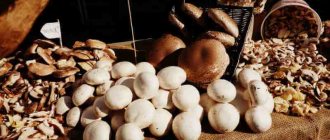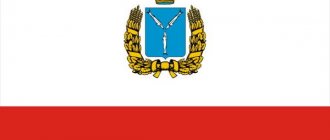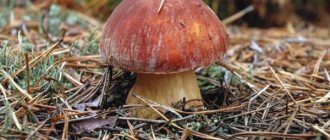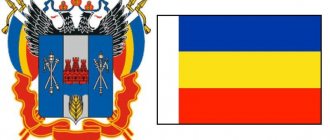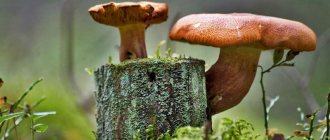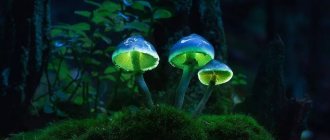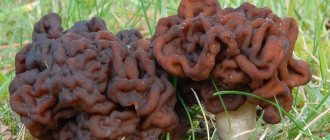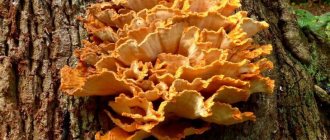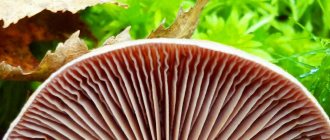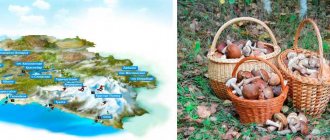Mushroom pickers of the Stavropol Territory begin to collect their forest harvest in May and finish in the last days of October, and under favorable weather conditions - in November. The 2022 season promises to be long and fruitful. Before going into the forest, it is important for a beginner to take time to carefully study the description of the characteristics and types of forest mushrooms. Often for this purpose they use a directory of mushrooms of the Stavropol Territory, which helps to correctly understand which mushrooms are edible and which are poisonous.
Edible
There are a great variety of edible species in the region. Every year, hobbyists collect large quantities of these tasty and healthy products.
Chanterelle
Chanterelles
The mushroom immediately catches the eye with its specific orange-beige color; it is impossible to confuse it with another. Chanterelles have a characteristic cap, a dense stem, and are slightly darker than the top.
It is found mainly in forests: pine, spruce, beech, oak. The fungus forms a symbiosis with them.
It is eaten in different forms, but the most common is salting or pickling.
This mushroom can easily survive bad weather, even slight frosts. Chanterelles appear already at the beginning of summer; these are early representatives of the class.
Saffron milk caps
It got its name for its red color, both caps and legs, and smells pleasantly of fruit. Saffron milk caps grow in coniferous forests, among pines and spruces.
It is a very valuable edible mushroom. It emerges in groups, forming a symbiosis with coniferous trees.
Ryzhik
Meadow mushrooms
Honey mushrooms
Honey mushrooms usually grow on trees, most often on log houses, which is why they got their name. A mushroom with a brownish cap and a white stalk can be found in the Stavropol forests in the autumn.
There are several types. All of them are edible, with the exception of their poisonous counterparts.
Honey mushrooms rarely grow alone, most often in groups of several.
Lilac-legged rower
Modest and inconspicuous mushrooms of gray-violet or ashy color. However, they are very tasty if fried.
Ryadovka
Green moss
This species grows on moss, which is why it is called that. Colored greenish-brown.
Found in deciduous and coniferous forests. Loves lit places. Found both in groups and alone.
Green moss
Russula food
Russula
Mushrooms are white-pink-bluish in color, often with cracked flesh. Quite tender and fragile. One of the most famous and widespread throughout Russia.
There are many varieties. Most of them fall into the edible or conditionally edible category. But there are species that should not be eaten.
boletus
It grows under birch trees, which is where its name comes from. Its brown cap and white stem make it look incredibly attractive.
boletus
Variegated champignon
Champignon
One of the noble representatives of the entire mushroom genus, along with white mushrooms, is of particular value for its unique taste and smell. This handsome white, small, rounded species loves warm climates, so it is often found in the Stavropol region.
Entoloma garden
Podslivnik (Entoloma garden)
It is found very often in the region. Grows in small groups in forests, gardens, often under rose bushes. It is considered a conditionally edible mushroom, which is suitable for pickling, pickling and frying.
The main danger is that there are similar look-alikes that can be poisonous.
Oyster mushrooms
Mushrooms are gray-bluish in color and grow on trees, often on dead ones. Their flat, flattened shape makes them often invisible. Oyster mushrooms, like honey mushrooms, grow in groups.
There is a fairly wide variety of species, most of them edible.
Autumn oyster mushroom
Beneficial features
The content of a large number of microelements and fiber in the fruiting bodies of edible mushrooms has been confirmed by modern science. The amount of protein contained in them is several times greater than that contained in animal and poultry meat. Because of this, mushrooms received another name - “forest meat”.
Mushrooms consist of 90% water, with virtually zero fat content, and therefore have a low calorie content, making them a possible addition to various types of diets for those seeking to lose weight. The composition contains 18 amino acids. They contain vitamins A, D, E, group B and nicotinic acid, which contribute to the overall strengthening of the body.
Regular consumption of mushrooms has anticancer and antitumor effects. Natural immunostimulation occurs due to a specific substance beta-glucan, which is part of the mushrooms.
Conditionally edible mushrooms of Stavropol
These mushrooms are called conditionally edible, since they taste worse than all the species listed above. They are soaked for a long time before heat treatment in order to benefit from them.
Real morel
Morels
Mushrooms whose cap resembles someone’s wrinkled face. The morel has a brown-brown cap and a whitish stem. It does not look very attractive in appearance, but is quite edible.
Cobwebs
The species has many colors and varieties, ranging from white to purple. If a mushroom picker managed to find representatives of this group, then you need to know that serious heat treatment is not possible here, since they are edible only after cooking.
1- Edible cobweb 2- Sparkling cobweb
Flavor categories
There are 4 flavor categories in total:
- Category 1: the most aromatic and delicious (different types of white, white and black milk mushrooms),
- Category 2: slightly worse in taste (boletus, boletus and volushki),
- Category 3: medium taste, with a weak aroma (moss mushrooms, mushrooms, honey mushrooms, russula, greenfinches),
- Category 4: mediocre taste and barely perceptible aroma (oyster mushrooms, hedgehog mushrooms, spider mushrooms, milkweed).
The last category refers to conditionally edible forest mushrooms. Their improper preparation leads to poisoning similar to poisoning with poisonous mushrooms.
Poisonous
These are mushrooms that need to be recognized very carefully. The well-known fly agaric, for example, is always visible from afar, but harmless honey mushrooms are easily confused with a false variety.
False honey fungus brick-red
Honey mushrooms are false
They differ from their useful counterparts in their thin stem, as well as the color under the cap. False honey mushrooms are bright yellow or brown, and honey mushrooms are light cream or white. Therefore, they are easy to distinguish by their characteristic color.
Satanic mushroom
boletus satanas
It is very poisonous, although it belongs to the same species as its noble white brother: boletus. It is distinguished by a thick bright red leg and a thick whitish cap.
False chanterelle
False chanterelles
They have a very bright, poisonous orange color, often uneven, in spots. Real chanterelles have an even color, light beige or pale orange.
Death cap
Record holder for the content of heaviest poisons. No less dangerous than its fellow fly agaric, it belongs to the same species. Easily distinguishable from edible mushrooms by their characteristic white, sometimes greenish color.
Toadstool pale
When does the season start?
Fruiting of mushrooms in the Krasnodar region begins in mid-June and continues until October. Under proper weather conditions, mushrooms begin to grow already in May, making them possible to collect earlier than usual.
Mushrooms are collected in the Krasnodar region during a period when the air temperature is stable and constant. Constant warmth, small soft rains, promoting an average humidity of 50% are optimal conditions for the growth of mushrooms.
The Krasnodar region is very rich in various types of mushrooms. This product is especially popular for consumption, because it can be used to prepare salads, add to soups and main courses. Mushroom pickers tirelessly go into the forests in search of edible mushrooms to sell them or for the purpose of conservation.
1
0
Copy link
Mushroom places
Many mushrooms can be found in the Caucasian Mineral Waters. Experienced mushroom pickers advise going there in search of boletus mushrooms, chanterelles and honey mushrooms. White mushrooms (boletus mushrooms) have taken root in the Russian Forest. Honey mushrooms, saffron milk caps and rows of mushrooms grow in the Taman Forest. Champignon lovers are recommended to visit the Stavropol Upland: noble representatives of the mushroom series have chosen these cozy and quiet places.
Routes
The Stavropol region does not have a large number of forests, but you can find a rich harvest of natural gifts in some places. Gorgeous pines grow in the Grachevsky district, and under them saffron milk caps are found in abundance. The lowland forests near the Kuban River are a real storehouse of various species of this unique wealth.
The main thing is safety
The latest mushroom gifts from Stavropol are the blue root. They grow in the steppe, in forest belts from November to January. It happens that even after frost they come out into the light. They usually “live” in families: if you find one clearing, dinner is provided. Both in summer and autumn you can see russula in the forest. It is difficult to transport them, as they are very fragile.
“Still, the most important thing for a mushroom picker is to remember safety,” notes Marina Titova. – Most often, people are irresponsible: a neighbor showed how to distinguish a good mushroom from a bad one, that’s all science. Still, a lot of experience is needed here. I wash my mushrooms at home and review every single one; if there is any doubt, I immediately throw it away.”
How to determine whether a mushroom is edible or not
Determining whether a mushroom is edible or inedible will not be difficult if you follow the advice of experts. It is always necessary to pay attention to obvious signs of inedibility:
- the body of the mushroom is wormy or with foulbrood;
- a sharp unpleasant odor emitted by old or poisonous specimens, which is especially noticeable if you break the cap;
- bright or too dark color, this is common in poisonous mushrooms, when edible ones have a uniform and delicate color.
Expert opinion
Melnikov Vladimir Mikhailovich
Knows 1000 ways to cook, pickle and marinate any types of mushrooms
When going mushroom picking, it wouldn’t hurt to take a more experienced friend with you or read specialized literature, which is abundant on bookstores or on the Internet.
Harmful properties
The delicacy is not a dietary product: it is difficult to digest. The food is heavy and should not be eaten haphazardly by those who have gastrointestinal problems. The digestion process slows down in the stomach and intestines. Chitin, which is mostly found in the legs of autumn species, when prepared incorrectly, triggers the process of rotting in the gastrointestinal tract.
In the environment, in the soil, there may be toxins that are completely absorbed by the vegetative body of mushrooms - the mycelium, especially those growing near busy roads. After improper preparation without soaking and thorough washing in several waters and canning of mushrooms, under favorable conditions, the active development of the causative agent of botulism begins in jars.
Release form and dosage
The recommended dosage of reishi varies depending on the dietary supplement. Fresh, you can consume from 25 to 100 g daily. Capsules, powder and extract contain a higher concentration of nutrients, which means the dosage of nutritional supplements should be lower.
Most studies have shown that 2-9 g of reishi mushroom extract in powder, capsules or infusion is enough to experience its beneficial effects. However, the concentration of this extract may vary, so please read the instructions on your package before use.
Artemisinin: a mysterious drug originating from Chinese traditional medicine
Assumption honey mushrooms (bulbous) - summer or autumn?
In 2022, Assumption honey mushrooms are equated not only with autumn, but also with summer subspecies. The reason for this is early fruiting, which is associated with weather conditions in many regions. Rainy days, combined with warm sunshine, contributed to the germination of honey mushrooms ahead of schedule.
A distinctive feature of these mushrooms is that they can grow not only on stumps, but also on the ground, camouflaging themselves in grass and autumn foliage. They are larger than their counterparts, and in size they reach the size of butterfish.
Summer honey mushrooms
Small, but very sweet and tasty summer mushrooms grow in June-August. Unlike their counterparts, they are small in size, light brown, one might even say reddish in color, and have a hard white leg with a girdling ring.
Patouillard fiberglass
It grows in entire families and is a representative of agaric fungi. It appears in coniferous and deciduous forests, as well as in parks and artificial forest belts already in early May and maintains its populations until August. It is found in both Asia and Europe.
When young, it has a white cone-shaped cap and can easily be confused with a champignon. With age it turns yellow and then turns red. The edge of the cap, whose diameter ranges from 3 to 9 cm, is wavy and cracks over time. The under-hat plates are thin, at first they are white, then darken and acquire a brown tint. The cylindrical stem of the mushroom is small in height - only 1.5 cm. It has a smooth surface and matches the color of the cap.
When cut, the white flesh turns slightly pink and attracts with a soft fruity aroma. An important feature: the entire mushroom is the same color, the stem at the bottom has a noticeable thickening.
